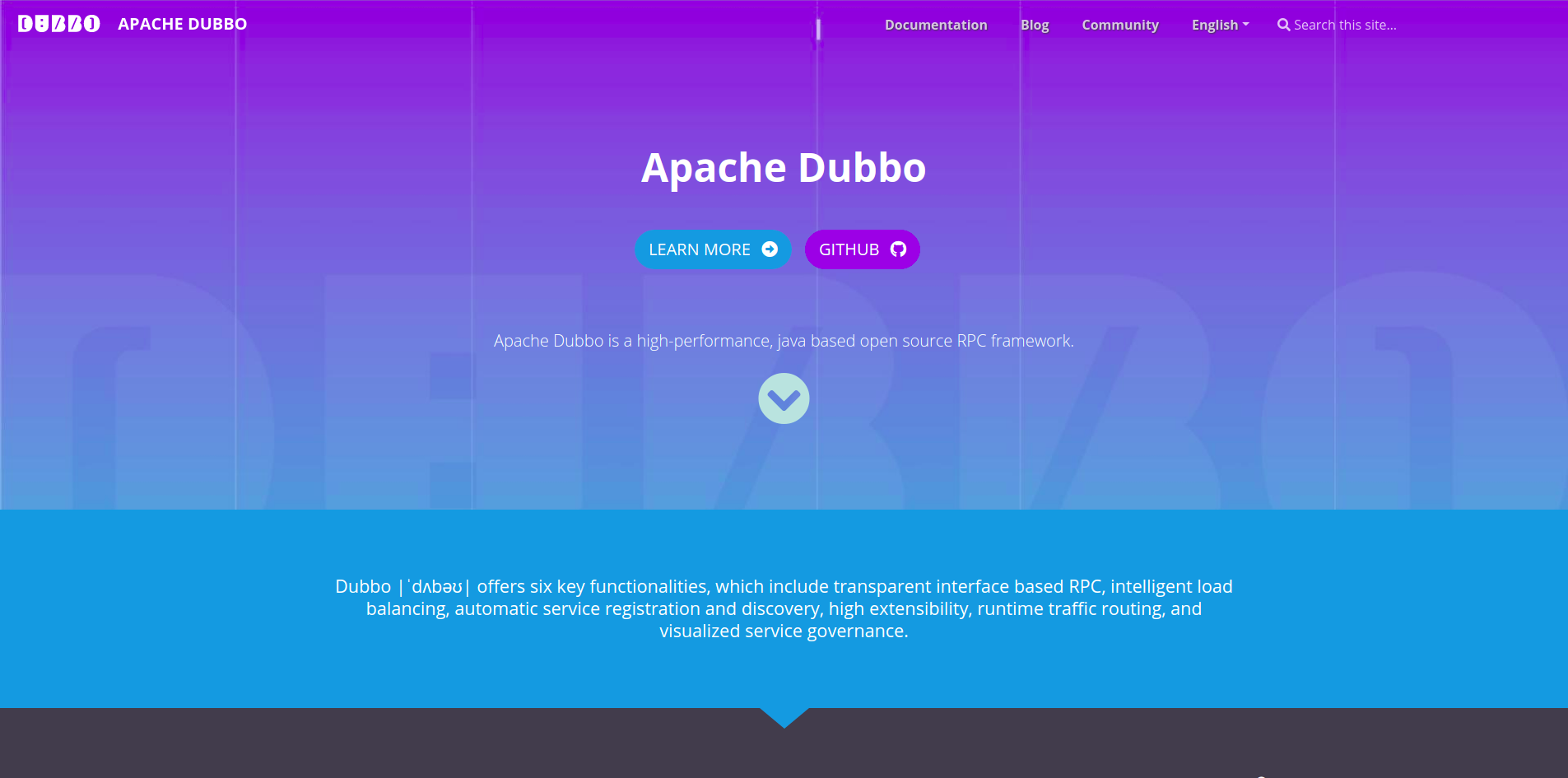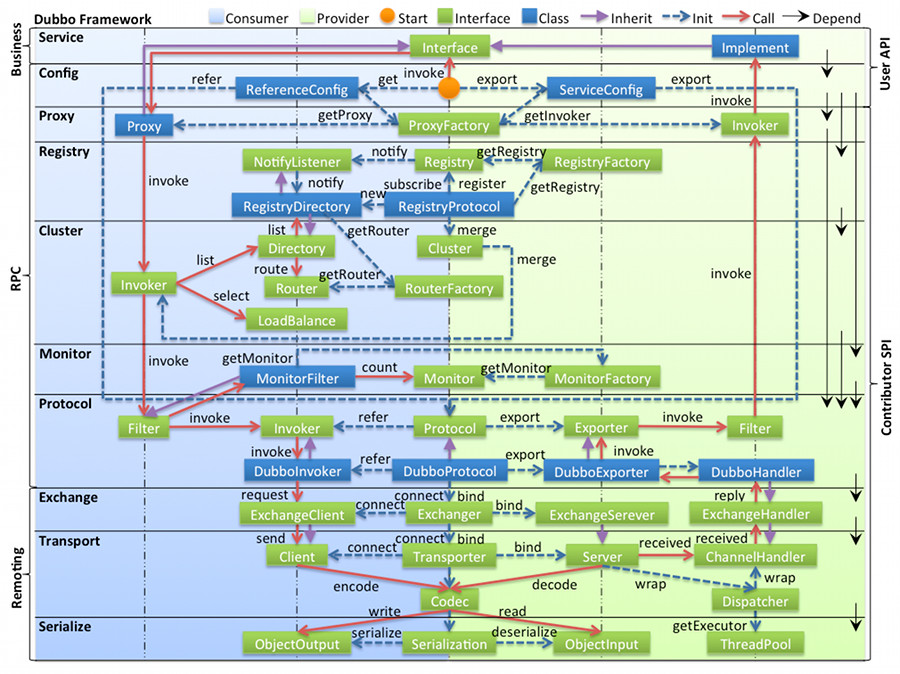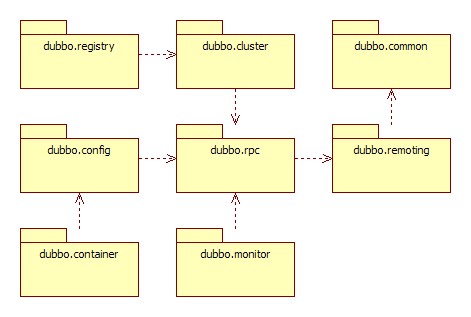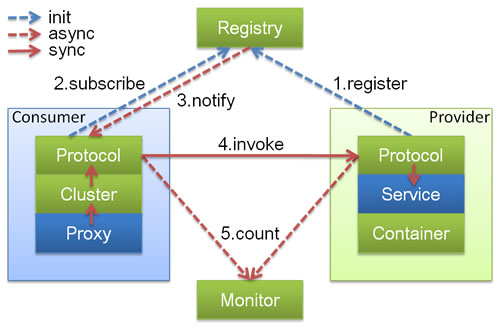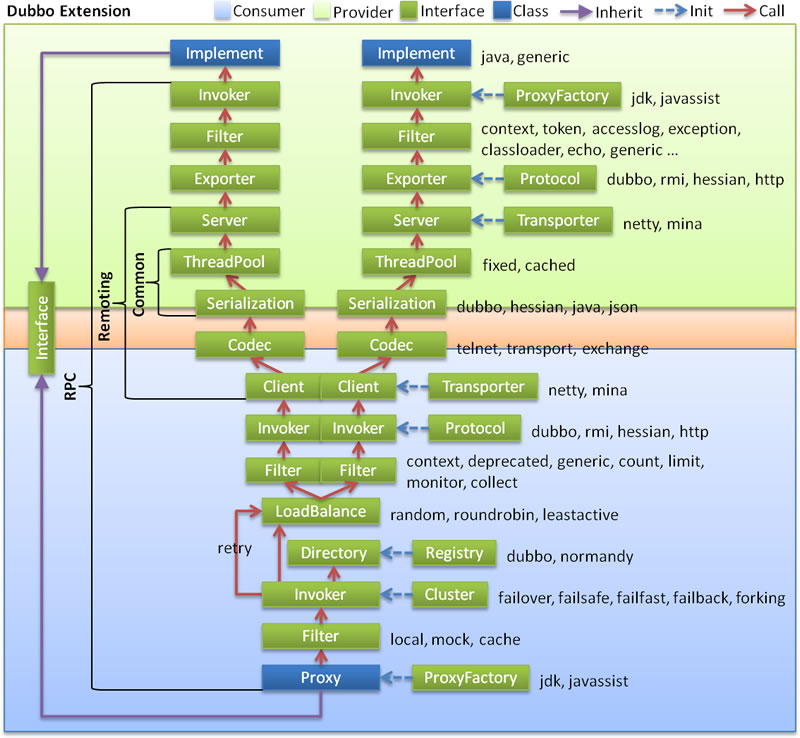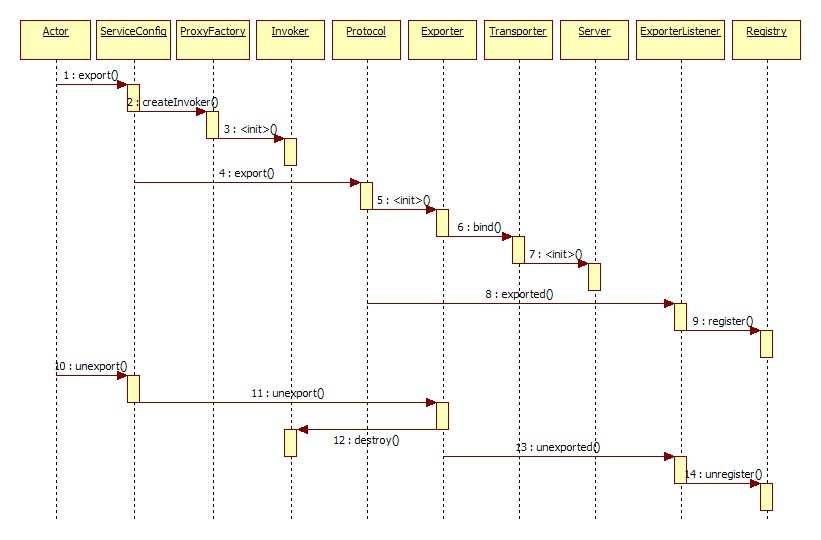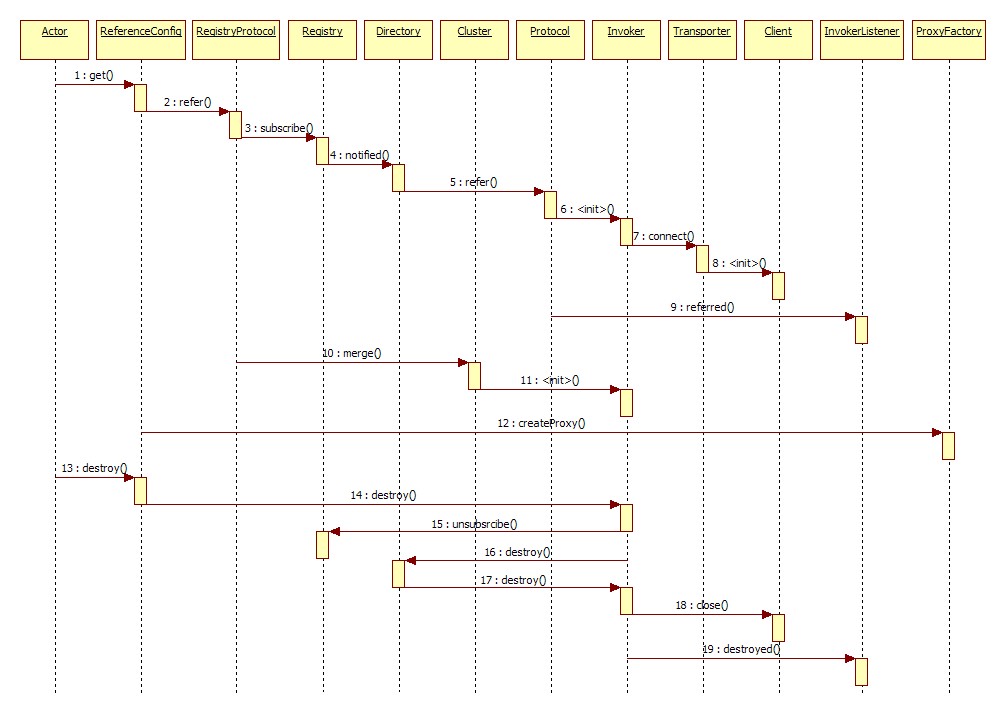框架简介
Apache Dubbo is a high-performance, java based open source RPC framework.
框架特点
Dubbo提供了基于高性能接口的RPC,对用户是透明的。
Dubbo支持开箱即用的多种负载平衡策略,可感知下游服务状态以减少总体延迟并提高系统吞吐量。
Dubbo支持多个服务注册表,可以立即检测在线/离线服务。
Dubbo的微内核和插件设计确保第三方实现可以轻松地将其扩展为协议,传输和序列化等核心功能。
可以在运行时配置Dubbo,以便可以根据不同的规则路由流量,这使得支持蓝绿色部署,数据中心感知路由等功能变得容易。
Dubbo提供了用于服务管理和维护的丰富工具,例如查询服务元数据,运行状况和统计信息。
快速开始 下载源码
1 2 3 git clone https://github.com/apache/dubbo.git dubbo
运行Zookeeper
1 2 3 4 wget https://downloads.apache.org/zookeeper/zookeeper-3.6.2/apache-zookeeper-3.6.2-bin.tar.gz
运行程序
先运行org.apache.dubbo.demo.provider.Application
再运行org.apache.dubbo.demo.consumer.Application
确保使用JDK1.8其他版本容易出问题
详细介绍
图例说明:
图中左边淡蓝背景的为服务消费方使用的接口,右边淡绿色背景的为服务提供方使用的接口,位于中轴线上的为双方都用到的接口。
图中从下至上分为十层,各层均为单向依赖,右边的黑色箭头代表层之间的依赖关系,每一层都可以剥离上层被复用,其中,Service 和 Config 层为 API,其它各层均为 SPI。
图中绿色小块的为扩展接口,蓝色小块为实现类,图中只显示用于关联各层的实现类。
图中蓝色虚线为初始化过程,即启动时组装链,红色实线为方法调用过程,即运行时调时链,紫色三角箭头为继承,可以把子类看作父类的同一个节点,线上的文字为调用的方法。
各层说明
config 配置层 :对外配置接口,以 ServiceConfig, ReferenceConfig 为中心,可以直接初始化配置类,也可以通过 spring 解析配置生成配置类proxy 服务代理层 :服务接口透明代理,生成服务的客户端 Stub 和服务器端 Skeleton, 以 ServiceProxy 为中心,扩展接口为 ProxyFactoryregistry 注册中心层 :封装服务地址的注册与发现,以服务 URL 为中心,扩展接口为 RegistryFactory, Registry, RegistryServicecluster 路由层 :封装多个提供者的路由及负载均衡,并桥接注册中心,以 Invoker 为中心,扩展接口为 Cluster, Directory, Router, LoadBalancemonitor 监控层 :RPC 调用次数和调用时间监控,以 Statistics 为中心,扩展接口为 MonitorFactory, Monitor, MonitorServiceprotocol 远程调用层 :封装 RPC 调用,以 Invocation, Result 为中心,扩展接口为 Protocol, Invoker, Exporterexchange 信息交换层 :封装请求响应模式,同步转异步,以 Request, Response 为中心,扩展接口为 Exchanger, ExchangeChannel, ExchangeClient, ExchangeServertransport 网络传输层 :抽象 mina 和 netty 为统一接口,以 Message 为中心,扩展接口为 Channel, Transporter, Client, Server, Codecserialize 数据序列化层 :可复用的一些工具,扩展接口为 Serialization, ObjectInput, ObjectOutput, ThreadPool
关系说明
在 RPC 中,Protocol 是核心层,也就是只要有 Protocol + Invoker + Exporter 就可以完成非透明的 RPC 调用,然后在 Invoker 的主过程上 Filter 拦截点。
图中的 Consumer 和 Provider 是抽象概念,只是想让看图者更直观的了解哪些类分属于客户端与服务器端,不用 Client 和 Server 的原因是 Dubbo 在很多场景下都使用 Provider, Consumer, Registry, Monitor 划分逻辑拓普节点,保持统一概念。
而 Cluster 是外围概念,所以 Cluster 的目的是将多个 Invoker 伪装成一个 Invoker,这样其它人只要关注 Protocol 层 Invoker 即可,加上 Cluster 或者去掉 Cluster 对其它层都不会造成影响,因为只有一个提供者时,是不需要 Cluster 的。
Proxy 层封装了所有接口的透明化代理,而在其它层都以 Invoker 为中心,只有到了暴露给用户使用时,才用 Proxy 将 Invoker 转成接口,或将接口实现转成 Invoker,也就是去掉 Proxy 层 RPC 是可以 Run 的,只是不那么透明,不那么看起来像调本地服务一样调远程服务。
而 Remoting 实现是 Dubbo 协议的实现,如果你选择 RMI 协议,整个 Remoting 都不会用上,Remoting 内部再划为 Transport 传输层和 Exchange 信息交换层,Transport 层只负责单向消息传输,是对 Mina, Netty, Grizzly 的抽象,它也可以扩展 UDP 传输,而 Exchange 层是在传输层之上封装了 Request-Response 语义。
Registry 和 Monitor 实际上不算一层,而是一个独立的节点,只是为了全局概览,用层的方式画在一起。
模块分包
模块说明:
dubbo-common 公共逻辑模块 :包括 Util 类和通用模型。dubbo-remoting 远程通讯模块 :相当于 Dubbo 协议的实现,如果 RPC 用 RMI协议则不需要使用此包。dubbo-rpc 远程调用模块 :抽象各种协议,以及动态代理,只包含一对一的调用,不关心集群的管理。dubbo-cluster 集群模块 :将多个服务提供方伪装为一个提供方,包括:负载均衡, 容错,路由等,集群的地址列表可以是静态配置的,也可以是由注册中心下发。dubbo-registry 注册中心模块 :基于注册中心下发地址的集群方式,以及对各种注册中心的抽象。dubbo-monitor 监控模块 :统计服务调用次数,调用时间的,调用链跟踪的服务。dubbo-config 配置模块 :是 Dubbo 对外的 API,用户通过 Config 使用Dubbo,隐藏 Dubbo 所有细节。dubbo-container 容器模块 :是一个 Standlone 的容器,以简单的 Main 加载 Spring 启动,因为服务通常不需要 Tomcat/JBoss 等 Web 容器的特性,没必要用 Web 容器去加载服务。
整体上按照分层结构进行分包,与分层的不同点在于:
container 为服务容器,用于部署运行服务,没有在层中画出。
protocol 层和 proxy 层都放在 rpc 模块中,这两层是 rpc 的核心,在不需要集群也就是只有一个提供者时,可以只使用这两层完成 rpc 调用。
transport 层和 exchange 层都放在 remoting 模块中,为 rpc 调用的通讯基础。
serialize 层放在 common 模块中,以便更大程度复用。
依赖关系
图例说明:
图中小方块 Protocol, Cluster, Proxy, Service, Container, Registry, Monitor 代表层或模块,蓝色的表示与业务有交互,绿色的表示只对 Dubbo 内部交互。
图中背景方块 Consumer, Provider, Registry, Monitor 代表部署逻辑拓扑节点。
图中蓝色虚线为初始化时调用,红色虚线为运行时异步调用,红色实线为运行时同步调用。
图中只包含 RPC 的层,不包含 Remoting 的层,Remoting 整体都隐含在 Protocol 中。
调用链 展开总设计图的红色调用链,如下:
暴露服务时序 展开总设计图左边服务提供方暴露服务的蓝色初始化链,时序图如下:
引用服务时序 展开总设计图右边服务消费方引用服务的蓝色初始化链,时序图如下:
领域模型 在 Dubbo 的核心领域模型中:
Protocol 是服务域,它是 Invoker 暴露和引用的主功能入口,它负责 Invoker 的生命周期管理。
Invoker 是实体域,它是 Dubbo 的核心模型,其它模型都向它靠扰,或转换成它,它代表一个可执行体,可向它发起 invoke 调用,它有可能是一个本地的实现,也可能是一个远程的实现,也可能一个集群实现。
Invocation 是会话域,它持有调用过程中的变量,比如方法名,参数等。
基本设计原则
采用 Microkernel + Plugin 模式,Microkernel 只负责组装 Plugin,Dubbo 自身的功能也是通过扩展点实现的,也就是 Dubbo 的所有功能点都可被用户自定义扩展所替换。
采用 URL 作为配置信息的统一格式,所有扩展点都通过传递 URL 携带配置信息。
源码分析 1 git clone https://github.com/apache/dubbo.git dubbo
简单用例分析 provider端
目录结构
1 2 3 4 5 6 7 8 9 10 11 12 13 14 15 16 dubbo-demo-xml-provider/src/
配置文件
1 2 3 4 5 6 7 8 9 10 11 12 13 14 15 16 17 18 19 20 21 22 23 <beans xmlns:xsi ="http://www.w3.org/2001/XMLSchema-instance" xmlns:dubbo ="http://dubbo.apache.org/schema/dubbo" xmlns ="http://www.springframework.org/schema/beans" xsi:schemaLocation ="http://www.springframework.org/schema/beans http://www.springframework.org/schema/beans/spring-beans-4.3.xsd http://dubbo.apache.org/schema/dubbo http://dubbo.apache.org/schema/dubbo/dubbo.xsd" ><dubbo:application name ="demo-provider" > <dubbo:parameter key ="mapping-type" value ="metadata" /> </dubbo:application > <dubbo:config-center address ="zookeeper://127.0.0.1:2181" /> <dubbo:metadata-report address ="zookeeper://127.0.0.1:2181" /> <dubbo:registry id ="registry1" address ="zookeeper://127.0.0.1:2181" /> <dubbo:protocol name ="dubbo" port ="-1" /> <bean id ="demoService" class ="org.apache.dubbo.demo.provider.DemoServiceImpl" /> <bean id ="greetingService" class ="org.apache.dubbo.demo.provider.GreetingServiceImpl" /> <dubbo:service interface ="org.apache.dubbo.demo.DemoService" timeout ="3000" ref ="demoService" registry ="registry1" /> <dubbo:service version ="1.0.0" group ="greeting" timeout ="5000" interface ="org.apache.dubbo.demo.GreetingService" ref ="greetingService" /> </beans >
应用类
1 2 3 4 5 6 7 public class Application {public static void main (String[] args) throws Exception {ClassPathXmlApplicationContext context = new ClassPathXmlApplicationContext ("spring/dubbo-provider.xml" );
1 2 3 4 5 6 7 8 9 10 11 12 13 14 15 16 17 18 19 20 21 22 23 24 25 26 27 public class DemoServiceImpl implements DemoService {private static final Logger logger = LoggerFactory.getLogger(DemoServiceImpl.class);@Override public String sayHello (String name) {"Hello " + name + ", request from consumer: " + RpcContext.getContext().getRemoteAddress());try {1000 );catch (InterruptedException e) {return "Hello " + name + ", response from provider: " + RpcContext.getContext().getLocalAddress();@Override public CompletableFuture<String> sayHelloAsync (String name) {return "async result" ;return cf;
1 2 3 4 5 6 public class GreetingServiceImpl implements GreetingService {@Override public String hello () {return "Greetings!" ;
consumer端
目录结构
1 2 3 4 5 6 7 8 9 10 11 12 13 14 dubbo-demo-xml-consumer/src/
配置文件
1 2 3 4 5 6 7 8 9 10 11 12 13 14 15 16 17 18 19 20 21 <beans xmlns:xsi ="http://www.w3.org/2001/XMLSchema-instance" xmlns:dubbo ="http://dubbo.apache.org/schema/dubbo" xmlns ="http://www.springframework.org/schema/beans" xsi:schemaLocation ="http://www.springframework.org/schema/beans http://www.springframework.org/schema/beans/spring-beans-4.3.xsd http://dubbo.apache.org/schema/dubbo http://dubbo.apache.org/schema/dubbo/dubbo.xsd" ><dubbo:application name ="demo-consumer" > <dubbo:parameter key ="mapping-type" value ="metadata" /> <dubbo:parameter key ="enable-auto-migration" value ="true" /> </dubbo:application > <dubbo:registry address ="zookeeper://127.0.0.1:2181" /> <dubbo:reference provided-by ="demo-provider" id ="demoService" check ="false" interface ="org.apache.dubbo.demo.DemoService" /> <dubbo:reference provided-by ="demo-provider" version ="1.0.0" group ="greeting" id ="greetingService" check ="false" interface ="org.apache.dubbo.demo.GreetingService" /> </beans >
应用类
1 2 3 4 5 6 7 8 9 10 11 12 13 14 15 16 17 18 19 20 21 22 23 24 25 26 27 28 29 30 31 32 33 34 35 36 37 public class Application {public static void main (String[] args) throws Exception {ClassPathXmlApplicationContext context = new ClassPathXmlApplicationContext ("spring/dubbo-consumer.xml" );DemoService demoService = context.getBean("demoService" , DemoService.class);GreetingService greetingService = context.getBean("greetingService" , GreetingService.class);new Thread (() -> {while (true ) {String greetings = greetingService.hello();" from separated thread." );try {100 );catch (InterruptedException e) {while (true ) {"world" );"result: " + hello.get());String greetings = greetingService.hello();"result: " + greetings);500 );
Dubbo Admin 目前的管理控制台已经发布 0.1 版本,结构上采取了前后端分离的方式,前端使用 Vue 和 Vuetify 分别作为 Javascript 框架和UI框架,后端采用 Spring Boot 框架。既可以按照标准的 Maven 方式进行打包,部署,也可以采用前后端分离的部署方式,方便开发,功能上,目前具备了服务查询,服务治理(包括 Dubbo 2.7 中新增的治理规则)以及服务测试三部分内容。
Maven方式部署
1 2 3 4 5 git clone https://github.com/apache/dubbo-admin.git
http://localhost:8080
前后端分离部署
1 2 3 cd dubbo-admin-ui
1 2 3 4 cd dubbo-admin-server
http://localhost:8081
配置: 1 配置文件为:
1 dubbo-admin-server/src/main/resources/application.properties
主要的配置有:
1 2 3 admin.config-center=zookeeper://127.0.0.1:2181
三个配置项分别指定了配置中心,注册中心和元数据中心的地址,关于这三个中心的详细说明,可以参考这里 。
也可以和 Dubbo 2.7 一样,在配置中心指定元数据和注册中心的地址,以 zookeeper 为例,配置的路径和内容如下:
1 2 3 # /dubbo/config/dubbo/dubbo.properties
配置中心里的地址会覆盖掉本地 application.properties 的配置
其他配置请访问 github 中的文档:
1 https://github.com/apache/dubbo-admin
Docker 方式运行 Start a Apache Dubbo Admin
1 docker run -p 8080:8080 apache/dubbo-admin
It will use all default configuration and connect to zookeeper://127.0.0.1:2181
… via docker stack deploy or docker-compose
1 2 3 4 5 6 7 8 9 10 11 12 13 14 15 16 17 version: '3'
Try in PWD
1 2 3 4 5 6 Environment variables
性能方面 参考资料 官方文档
